University HRM Research: COVID-19 and Workforce Management
VerifiedAdded on 2023/05/29
|48
|14975
|427
Report
AI Summary
This research report examines the profound impact of the COVID-19 pandemic on Human Resource Management (HRM), focusing on the evolving patterns, challenges, and opportunities within the workforce. The study, based on interviews with HR managers in the UK retail sector, investigates how HRM practices have adapted to the pandemic, including recruitment, training, and performance management. The report delves into the challenges of remote work, employee engagement, and the need for innovative HR strategies. It reviews existing literature, explores the role of interpretivism and inductive reasoning in understanding the subjective experiences of HR managers, and provides recommendations for enhancing HRM approaches. The research highlights the need for organizations to address issues of employee well-being, maintain a positive work environment, and adapt to the changing needs of the workforce in a post-pandemic world. The report also identifies areas for future research, contributing valuable insights for both academics and HR professionals.
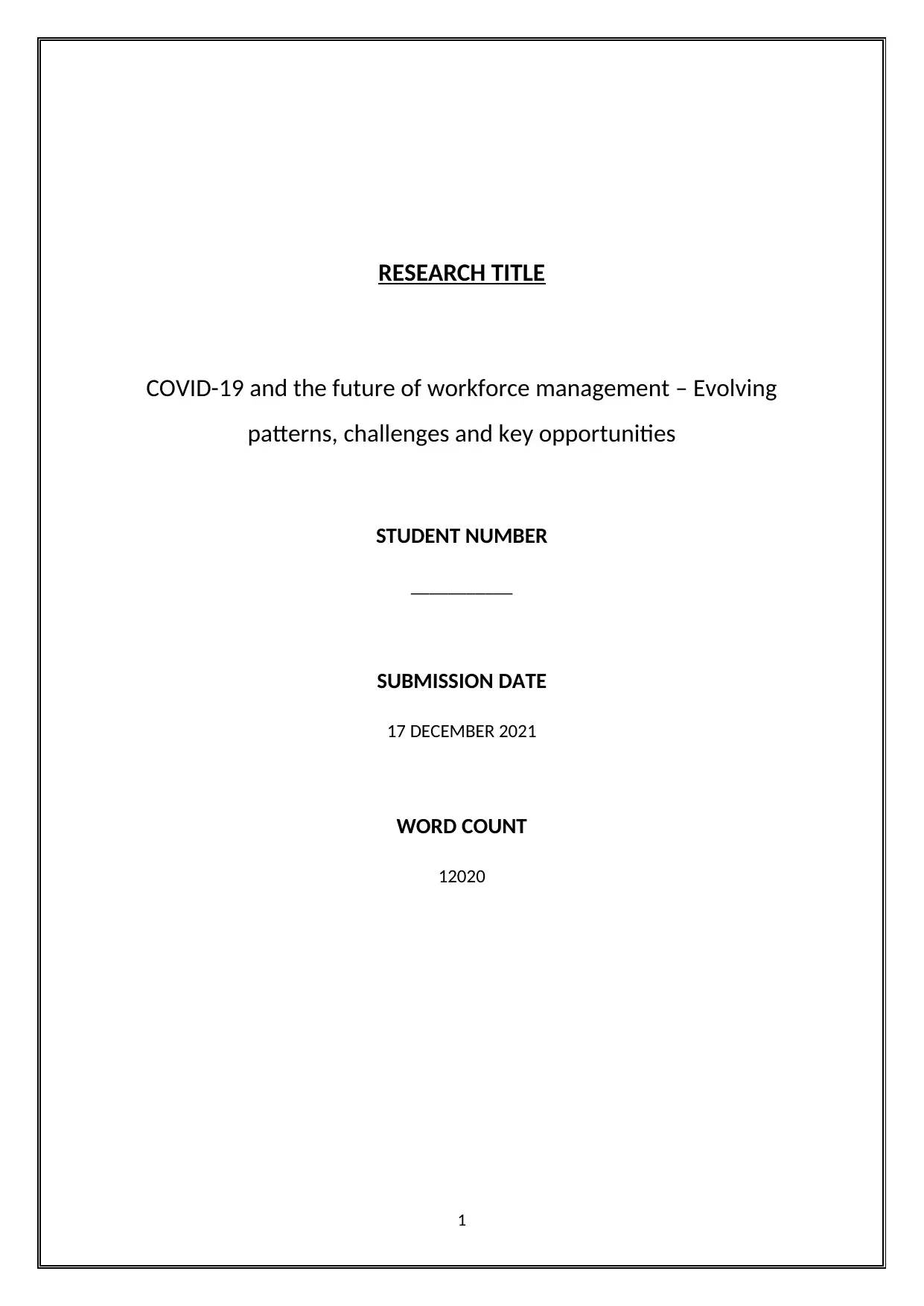
RESEARCH TITLE
COVID-19 and the future of workforce management – Evolving
patterns, challenges and key opportunities
STUDENT NUMBER
___________
SUBMISSION DATE
17 DECEMBER 2021
WORD COUNT
12020
1
COVID-19 and the future of workforce management – Evolving
patterns, challenges and key opportunities
STUDENT NUMBER
___________
SUBMISSION DATE
17 DECEMBER 2021
WORD COUNT
12020
1
Paraphrase This Document
Need a fresh take? Get an instant paraphrase of this document with our AI Paraphraser
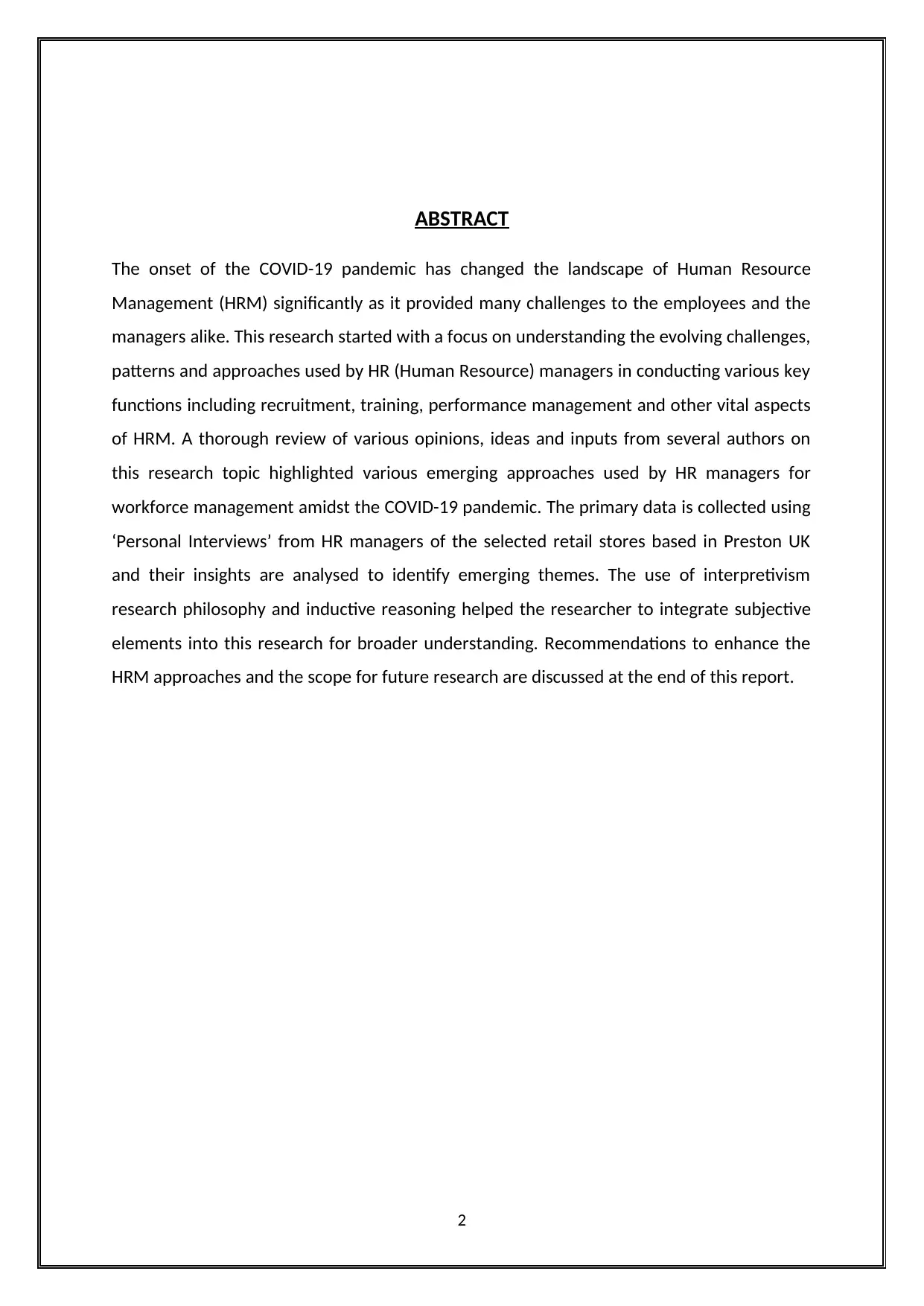
ABSTRACT
The onset of the COVID-19 pandemic has changed the landscape of Human Resource
Management (HRM) significantly as it provided many challenges to the employees and the
managers alike. This research started with a focus on understanding the evolving challenges,
patterns and approaches used by HR (Human Resource) managers in conducting various key
functions including recruitment, training, performance management and other vital aspects
of HRM. A thorough review of various opinions, ideas and inputs from several authors on
this research topic highlighted various emerging approaches used by HR managers for
workforce management amidst the COVID-19 pandemic. The primary data is collected using
‘Personal Interviews’ from HR managers of the selected retail stores based in Preston UK
and their insights are analysed to identify emerging themes. The use of interpretivism
research philosophy and inductive reasoning helped the researcher to integrate subjective
elements into this research for broader understanding. Recommendations to enhance the
HRM approaches and the scope for future research are discussed at the end of this report.
2
The onset of the COVID-19 pandemic has changed the landscape of Human Resource
Management (HRM) significantly as it provided many challenges to the employees and the
managers alike. This research started with a focus on understanding the evolving challenges,
patterns and approaches used by HR (Human Resource) managers in conducting various key
functions including recruitment, training, performance management and other vital aspects
of HRM. A thorough review of various opinions, ideas and inputs from several authors on
this research topic highlighted various emerging approaches used by HR managers for
workforce management amidst the COVID-19 pandemic. The primary data is collected using
‘Personal Interviews’ from HR managers of the selected retail stores based in Preston UK
and their insights are analysed to identify emerging themes. The use of interpretivism
research philosophy and inductive reasoning helped the researcher to integrate subjective
elements into this research for broader understanding. Recommendations to enhance the
HRM approaches and the scope for future research are discussed at the end of this report.
2
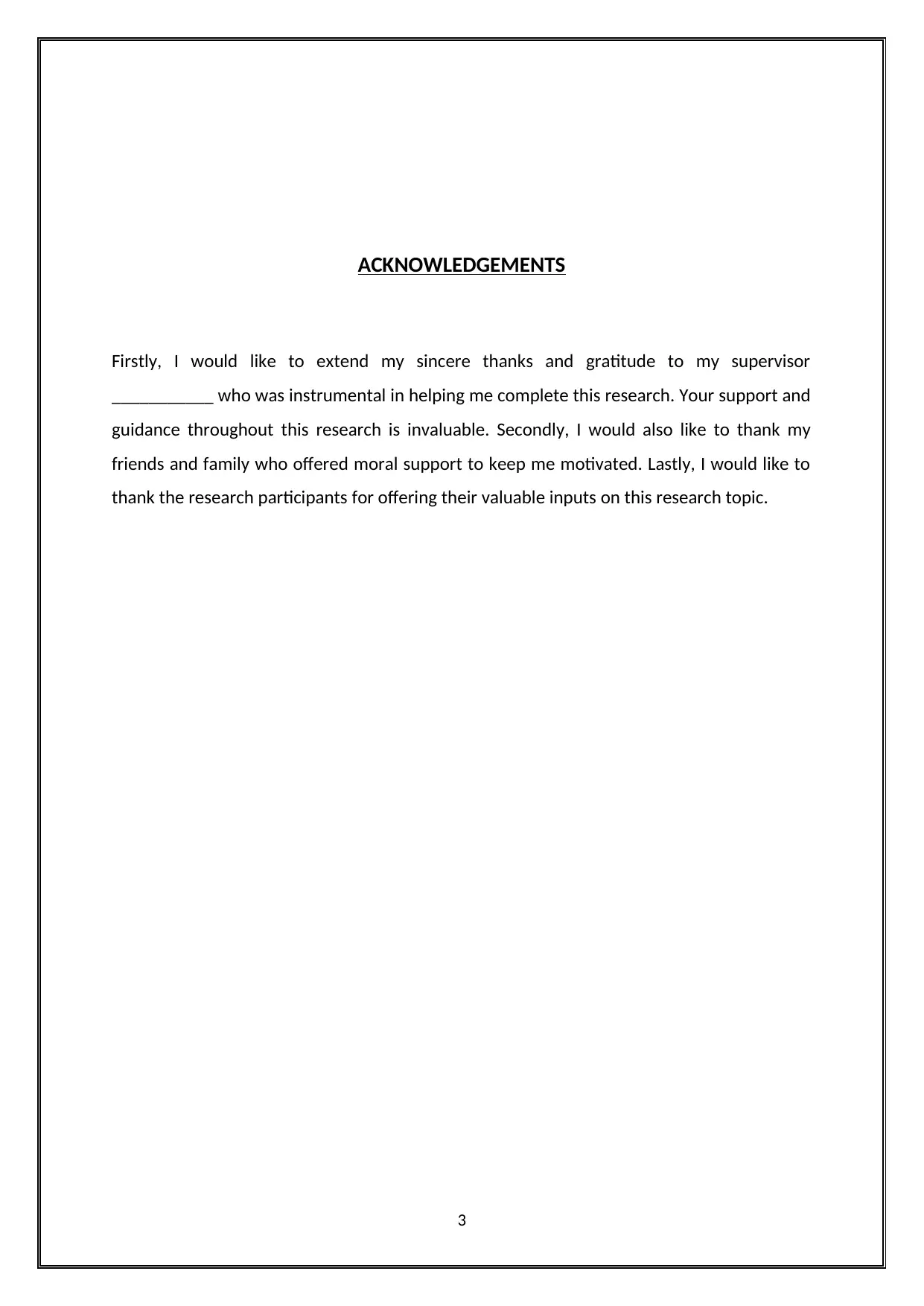
ACKNOWLEDGEMENTS
Firstly, I would like to extend my sincere thanks and gratitude to my supervisor
___________ who was instrumental in helping me complete this research. Your support and
guidance throughout this research is invaluable. Secondly, I would also like to thank my
friends and family who offered moral support to keep me motivated. Lastly, I would like to
thank the research participants for offering their valuable inputs on this research topic.
3
Firstly, I would like to extend my sincere thanks and gratitude to my supervisor
___________ who was instrumental in helping me complete this research. Your support and
guidance throughout this research is invaluable. Secondly, I would also like to thank my
friends and family who offered moral support to keep me motivated. Lastly, I would like to
thank the research participants for offering their valuable inputs on this research topic.
3
⊘ This is a preview!⊘
Do you want full access?
Subscribe today to unlock all pages.

Trusted by 1+ million students worldwide
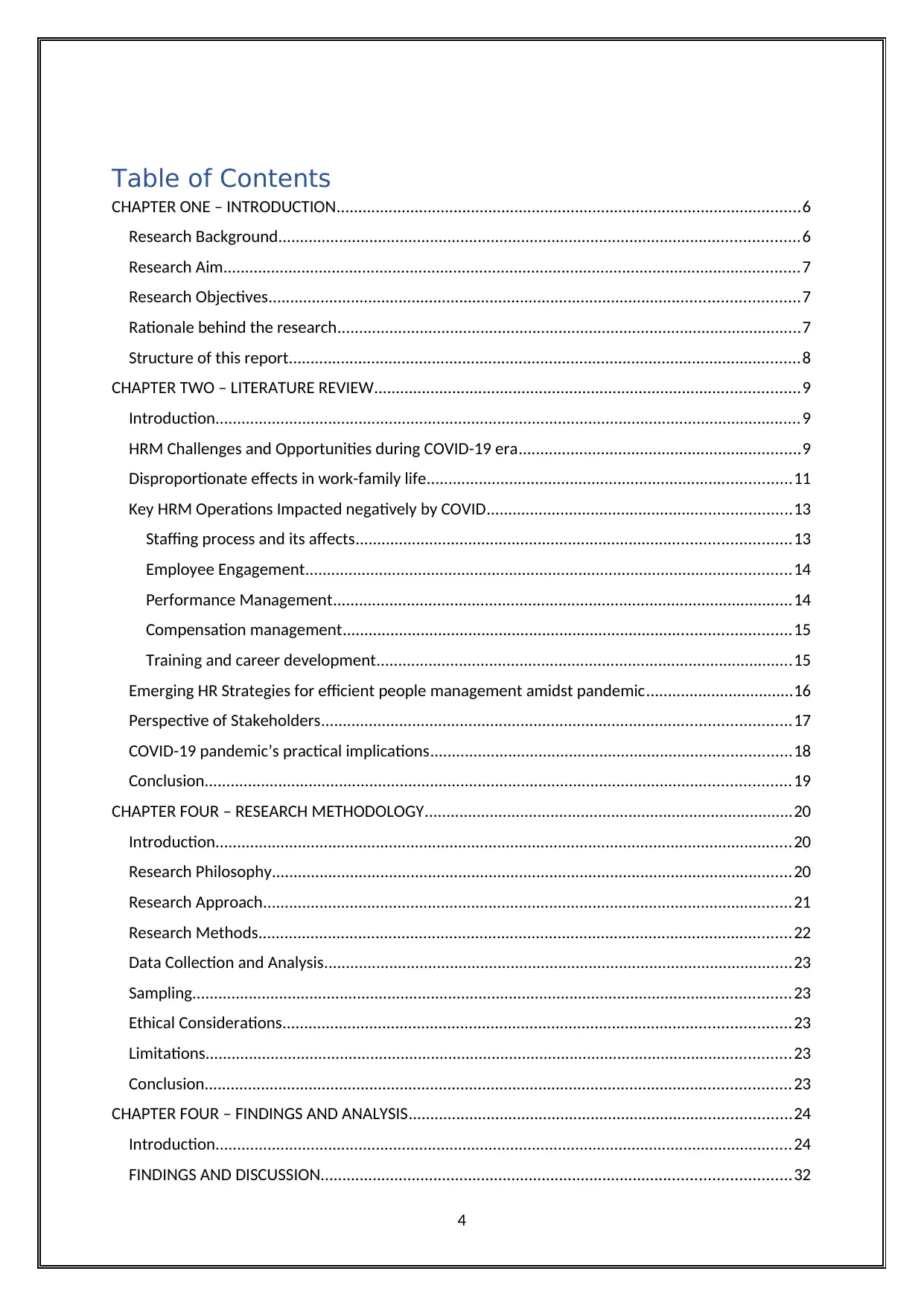
Table of Contents
CHAPTER ONE – INTRODUCTION...........................................................................................................6
Research Background........................................................................................................................6
Research Aim.....................................................................................................................................7
Research Objectives..........................................................................................................................7
Rationale behind the research...........................................................................................................7
Structure of this report......................................................................................................................8
CHAPTER TWO – LITERATURE REVIEW..................................................................................................9
Introduction.......................................................................................................................................9
HRM Challenges and Opportunities during COVID-19 era.................................................................9
Disproportionate effects in work-family life....................................................................................11
Key HRM Operations Impacted negatively by COVID......................................................................13
Staffing process and its affects....................................................................................................13
Employee Engagement................................................................................................................14
Performance Management..........................................................................................................14
Compensation management.......................................................................................................15
Training and career development................................................................................................15
Emerging HR Strategies for efficient people management amidst pandemic..................................16
Perspective of Stakeholders............................................................................................................17
COVID-19 pandemic’s practical implications...................................................................................18
Conclusion.......................................................................................................................................19
CHAPTER FOUR – RESEARCH METHODOLOGY.....................................................................................20
Introduction.....................................................................................................................................20
Research Philosophy........................................................................................................................20
Research Approach..........................................................................................................................21
Research Methods...........................................................................................................................22
Data Collection and Analysis............................................................................................................23
Sampling..........................................................................................................................................23
Ethical Considerations.....................................................................................................................23
Limitations.......................................................................................................................................23
Conclusion.......................................................................................................................................23
CHAPTER FOUR – FINDINGS AND ANALYSIS........................................................................................24
Introduction.....................................................................................................................................24
FINDINGS AND DISCUSSION............................................................................................................32
4
CHAPTER ONE – INTRODUCTION...........................................................................................................6
Research Background........................................................................................................................6
Research Aim.....................................................................................................................................7
Research Objectives..........................................................................................................................7
Rationale behind the research...........................................................................................................7
Structure of this report......................................................................................................................8
CHAPTER TWO – LITERATURE REVIEW..................................................................................................9
Introduction.......................................................................................................................................9
HRM Challenges and Opportunities during COVID-19 era.................................................................9
Disproportionate effects in work-family life....................................................................................11
Key HRM Operations Impacted negatively by COVID......................................................................13
Staffing process and its affects....................................................................................................13
Employee Engagement................................................................................................................14
Performance Management..........................................................................................................14
Compensation management.......................................................................................................15
Training and career development................................................................................................15
Emerging HR Strategies for efficient people management amidst pandemic..................................16
Perspective of Stakeholders............................................................................................................17
COVID-19 pandemic’s practical implications...................................................................................18
Conclusion.......................................................................................................................................19
CHAPTER FOUR – RESEARCH METHODOLOGY.....................................................................................20
Introduction.....................................................................................................................................20
Research Philosophy........................................................................................................................20
Research Approach..........................................................................................................................21
Research Methods...........................................................................................................................22
Data Collection and Analysis............................................................................................................23
Sampling..........................................................................................................................................23
Ethical Considerations.....................................................................................................................23
Limitations.......................................................................................................................................23
Conclusion.......................................................................................................................................23
CHAPTER FOUR – FINDINGS AND ANALYSIS........................................................................................24
Introduction.....................................................................................................................................24
FINDINGS AND DISCUSSION............................................................................................................32
4
Paraphrase This Document
Need a fresh take? Get an instant paraphrase of this document with our AI Paraphraser
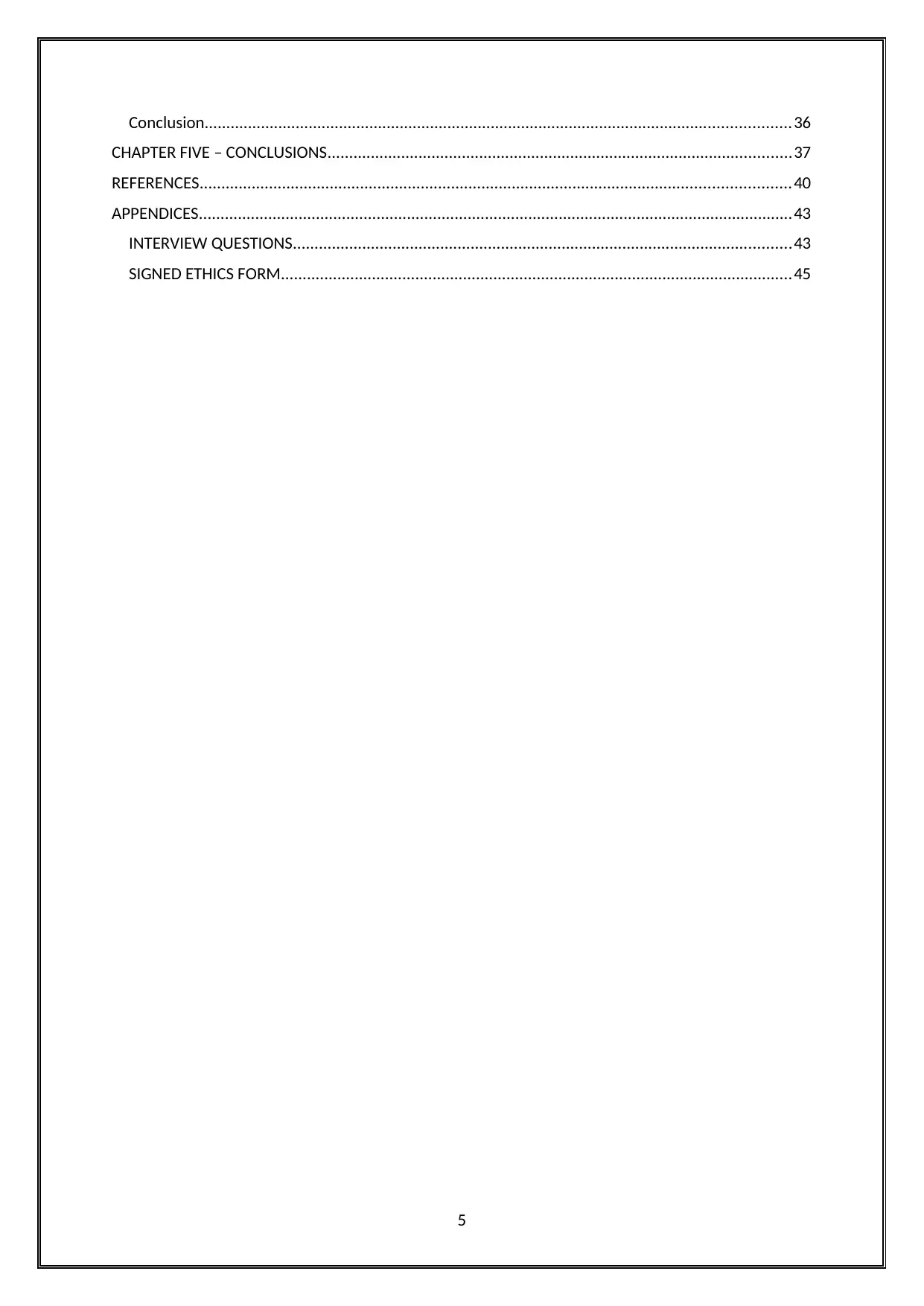
Conclusion.......................................................................................................................................36
CHAPTER FIVE – CONCLUSIONS...........................................................................................................37
REFERENCES........................................................................................................................................40
APPENDICES.........................................................................................................................................43
INTERVIEW QUESTIONS...................................................................................................................43
SIGNED ETHICS FORM......................................................................................................................45
5
CHAPTER FIVE – CONCLUSIONS...........................................................................................................37
REFERENCES........................................................................................................................................40
APPENDICES.........................................................................................................................................43
INTERVIEW QUESTIONS...................................................................................................................43
SIGNED ETHICS FORM......................................................................................................................45
5
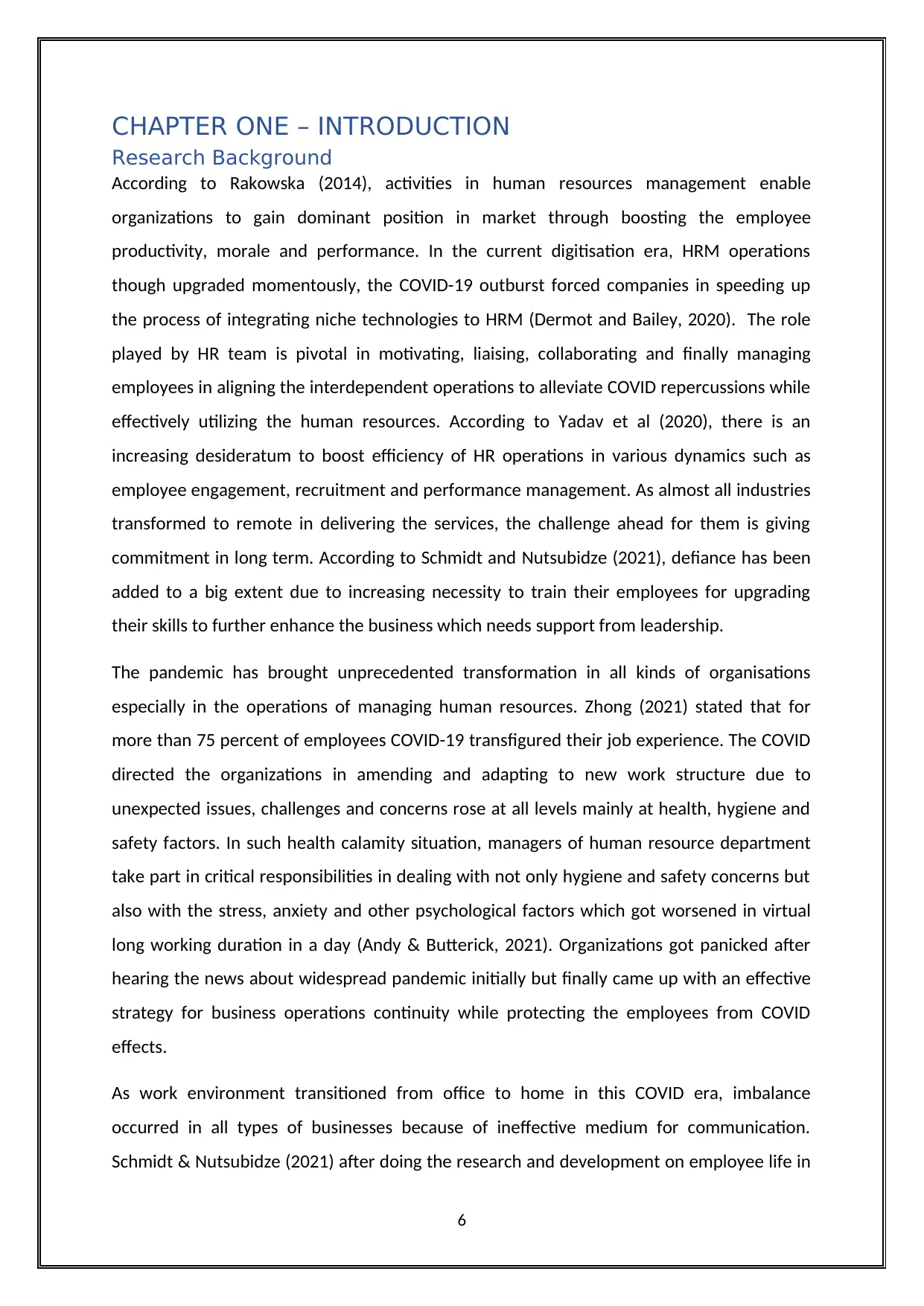
CHAPTER ONE – INTRODUCTION
Research Background
According to Rakowska (2014), activities in human resources management enable
organizations to gain dominant position in market through boosting the employee
productivity, morale and performance. In the current digitisation era, HRM operations
though upgraded momentously, the COVID-19 outburst forced companies in speeding up
the process of integrating niche technologies to HRM (Dermot and Bailey, 2020). The role
played by HR team is pivotal in motivating, liaising, collaborating and finally managing
employees in aligning the interdependent operations to alleviate COVID repercussions while
effectively utilizing the human resources. According to Yadav et al (2020), there is an
increasing desideratum to boost efficiency of HR operations in various dynamics such as
employee engagement, recruitment and performance management. As almost all industries
transformed to remote in delivering the services, the challenge ahead for them is giving
commitment in long term. According to Schmidt and Nutsubidze (2021), defiance has been
added to a big extent due to increasing necessity to train their employees for upgrading
their skills to further enhance the business which needs support from leadership.
The pandemic has brought unprecedented transformation in all kinds of organisations
especially in the operations of managing human resources. Zhong (2021) stated that for
more than 75 percent of employees COVID-19 transfigured their job experience. The COVID
directed the organizations in amending and adapting to new work structure due to
unexpected issues, challenges and concerns rose at all levels mainly at health, hygiene and
safety factors. In such health calamity situation, managers of human resource department
take part in critical responsibilities in dealing with not only hygiene and safety concerns but
also with the stress, anxiety and other psychological factors which got worsened in virtual
long working duration in a day (Andy & Butterick, 2021). Organizations got panicked after
hearing the news about widespread pandemic initially but finally came up with an effective
strategy for business operations continuity while protecting the employees from COVID
effects.
As work environment transitioned from office to home in this COVID era, imbalance
occurred in all types of businesses because of ineffective medium for communication.
Schmidt & Nutsubidze (2021) after doing the research and development on employee life in
6
Research Background
According to Rakowska (2014), activities in human resources management enable
organizations to gain dominant position in market through boosting the employee
productivity, morale and performance. In the current digitisation era, HRM operations
though upgraded momentously, the COVID-19 outburst forced companies in speeding up
the process of integrating niche technologies to HRM (Dermot and Bailey, 2020). The role
played by HR team is pivotal in motivating, liaising, collaborating and finally managing
employees in aligning the interdependent operations to alleviate COVID repercussions while
effectively utilizing the human resources. According to Yadav et al (2020), there is an
increasing desideratum to boost efficiency of HR operations in various dynamics such as
employee engagement, recruitment and performance management. As almost all industries
transformed to remote in delivering the services, the challenge ahead for them is giving
commitment in long term. According to Schmidt and Nutsubidze (2021), defiance has been
added to a big extent due to increasing necessity to train their employees for upgrading
their skills to further enhance the business which needs support from leadership.
The pandemic has brought unprecedented transformation in all kinds of organisations
especially in the operations of managing human resources. Zhong (2021) stated that for
more than 75 percent of employees COVID-19 transfigured their job experience. The COVID
directed the organizations in amending and adapting to new work structure due to
unexpected issues, challenges and concerns rose at all levels mainly at health, hygiene and
safety factors. In such health calamity situation, managers of human resource department
take part in critical responsibilities in dealing with not only hygiene and safety concerns but
also with the stress, anxiety and other psychological factors which got worsened in virtual
long working duration in a day (Andy & Butterick, 2021). Organizations got panicked after
hearing the news about widespread pandemic initially but finally came up with an effective
strategy for business operations continuity while protecting the employees from COVID
effects.
As work environment transitioned from office to home in this COVID era, imbalance
occurred in all types of businesses because of ineffective medium for communication.
Schmidt & Nutsubidze (2021) after doing the research and development on employee life in
6
⊘ This is a preview!⊘
Do you want full access?
Subscribe today to unlock all pages.

Trusted by 1+ million students worldwide
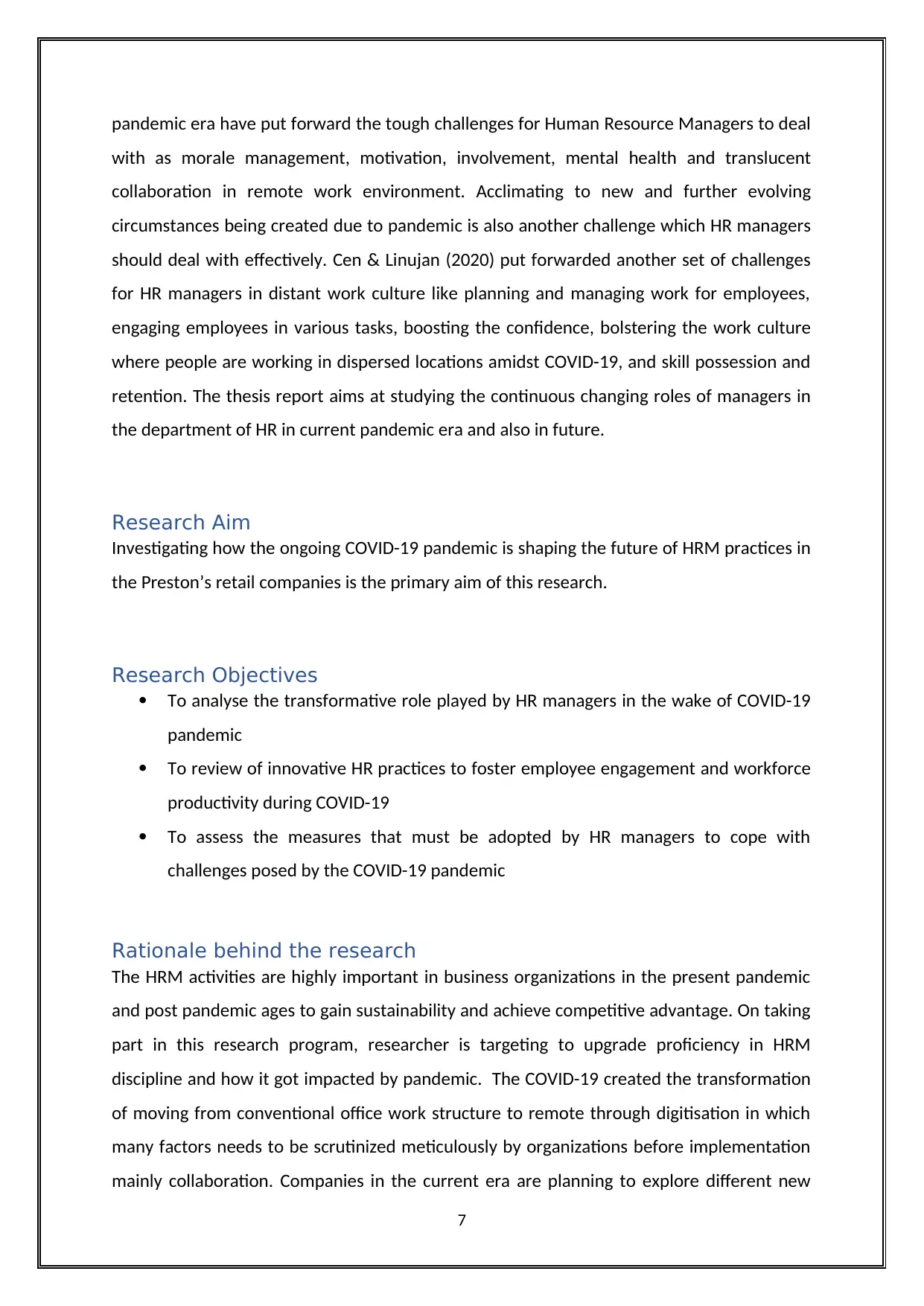
pandemic era have put forward the tough challenges for Human Resource Managers to deal
with as morale management, motivation, involvement, mental health and translucent
collaboration in remote work environment. Acclimating to new and further evolving
circumstances being created due to pandemic is also another challenge which HR managers
should deal with effectively. Cen & Linujan (2020) put forwarded another set of challenges
for HR managers in distant work culture like planning and managing work for employees,
engaging employees in various tasks, boosting the confidence, bolstering the work culture
where people are working in dispersed locations amidst COVID-19, and skill possession and
retention. The thesis report aims at studying the continuous changing roles of managers in
the department of HR in current pandemic era and also in future.
Research Aim
Investigating how the ongoing COVID-19 pandemic is shaping the future of HRM practices in
the Preston’s retail companies is the primary aim of this research.
Research Objectives
To analyse the transformative role played by HR managers in the wake of COVID-19
pandemic
To review of innovative HR practices to foster employee engagement and workforce
productivity during COVID-19
To assess the measures that must be adopted by HR managers to cope with
challenges posed by the COVID-19 pandemic
Rationale behind the research
The HRM activities are highly important in business organizations in the present pandemic
and post pandemic ages to gain sustainability and achieve competitive advantage. On taking
part in this research program, researcher is targeting to upgrade proficiency in HRM
discipline and how it got impacted by pandemic. The COVID-19 created the transformation
of moving from conventional office work structure to remote through digitisation in which
many factors needs to be scrutinized meticulously by organizations before implementation
mainly collaboration. Companies in the current era are planning to explore different new
7
with as morale management, motivation, involvement, mental health and translucent
collaboration in remote work environment. Acclimating to new and further evolving
circumstances being created due to pandemic is also another challenge which HR managers
should deal with effectively. Cen & Linujan (2020) put forwarded another set of challenges
for HR managers in distant work culture like planning and managing work for employees,
engaging employees in various tasks, boosting the confidence, bolstering the work culture
where people are working in dispersed locations amidst COVID-19, and skill possession and
retention. The thesis report aims at studying the continuous changing roles of managers in
the department of HR in current pandemic era and also in future.
Research Aim
Investigating how the ongoing COVID-19 pandemic is shaping the future of HRM practices in
the Preston’s retail companies is the primary aim of this research.
Research Objectives
To analyse the transformative role played by HR managers in the wake of COVID-19
pandemic
To review of innovative HR practices to foster employee engagement and workforce
productivity during COVID-19
To assess the measures that must be adopted by HR managers to cope with
challenges posed by the COVID-19 pandemic
Rationale behind the research
The HRM activities are highly important in business organizations in the present pandemic
and post pandemic ages to gain sustainability and achieve competitive advantage. On taking
part in this research program, researcher is targeting to upgrade proficiency in HRM
discipline and how it got impacted by pandemic. The COVID-19 created the transformation
of moving from conventional office work structure to remote through digitisation in which
many factors needs to be scrutinized meticulously by organizations before implementation
mainly collaboration. Companies in the current era are planning to explore different new
7
Paraphrase This Document
Need a fresh take? Get an instant paraphrase of this document with our AI Paraphraser
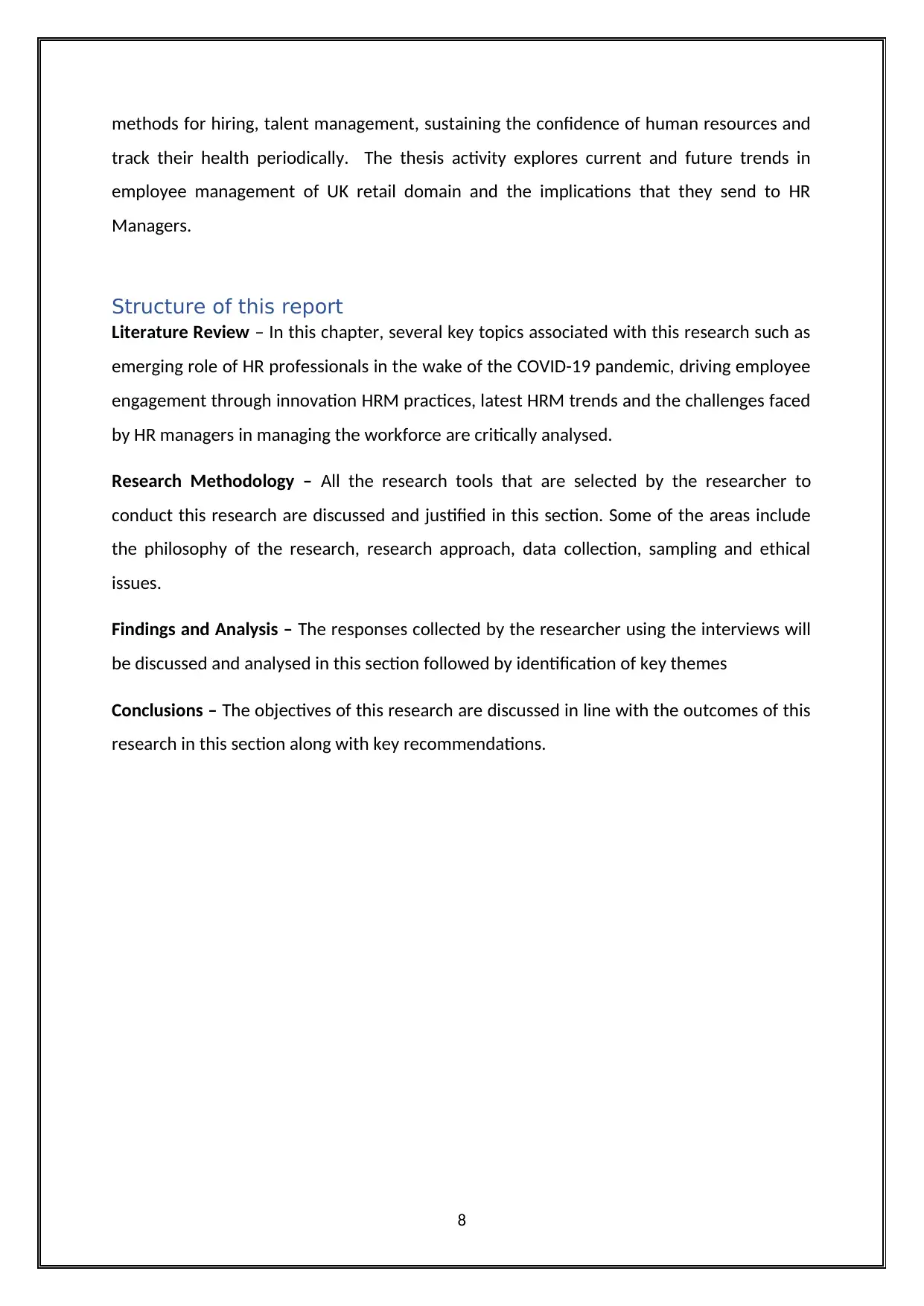
methods for hiring, talent management, sustaining the confidence of human resources and
track their health periodically. The thesis activity explores current and future trends in
employee management of UK retail domain and the implications that they send to HR
Managers.
Structure of this report
Literature Review – In this chapter, several key topics associated with this research such as
emerging role of HR professionals in the wake of the COVID-19 pandemic, driving employee
engagement through innovation HRM practices, latest HRM trends and the challenges faced
by HR managers in managing the workforce are critically analysed.
Research Methodology – All the research tools that are selected by the researcher to
conduct this research are discussed and justified in this section. Some of the areas include
the philosophy of the research, research approach, data collection, sampling and ethical
issues.
Findings and Analysis – The responses collected by the researcher using the interviews will
be discussed and analysed in this section followed by identification of key themes
Conclusions – The objectives of this research are discussed in line with the outcomes of this
research in this section along with key recommendations.
8
track their health periodically. The thesis activity explores current and future trends in
employee management of UK retail domain and the implications that they send to HR
Managers.
Structure of this report
Literature Review – In this chapter, several key topics associated with this research such as
emerging role of HR professionals in the wake of the COVID-19 pandemic, driving employee
engagement through innovation HRM practices, latest HRM trends and the challenges faced
by HR managers in managing the workforce are critically analysed.
Research Methodology – All the research tools that are selected by the researcher to
conduct this research are discussed and justified in this section. Some of the areas include
the philosophy of the research, research approach, data collection, sampling and ethical
issues.
Findings and Analysis – The responses collected by the researcher using the interviews will
be discussed and analysed in this section followed by identification of key themes
Conclusions – The objectives of this research are discussed in line with the outcomes of this
research in this section along with key recommendations.
8
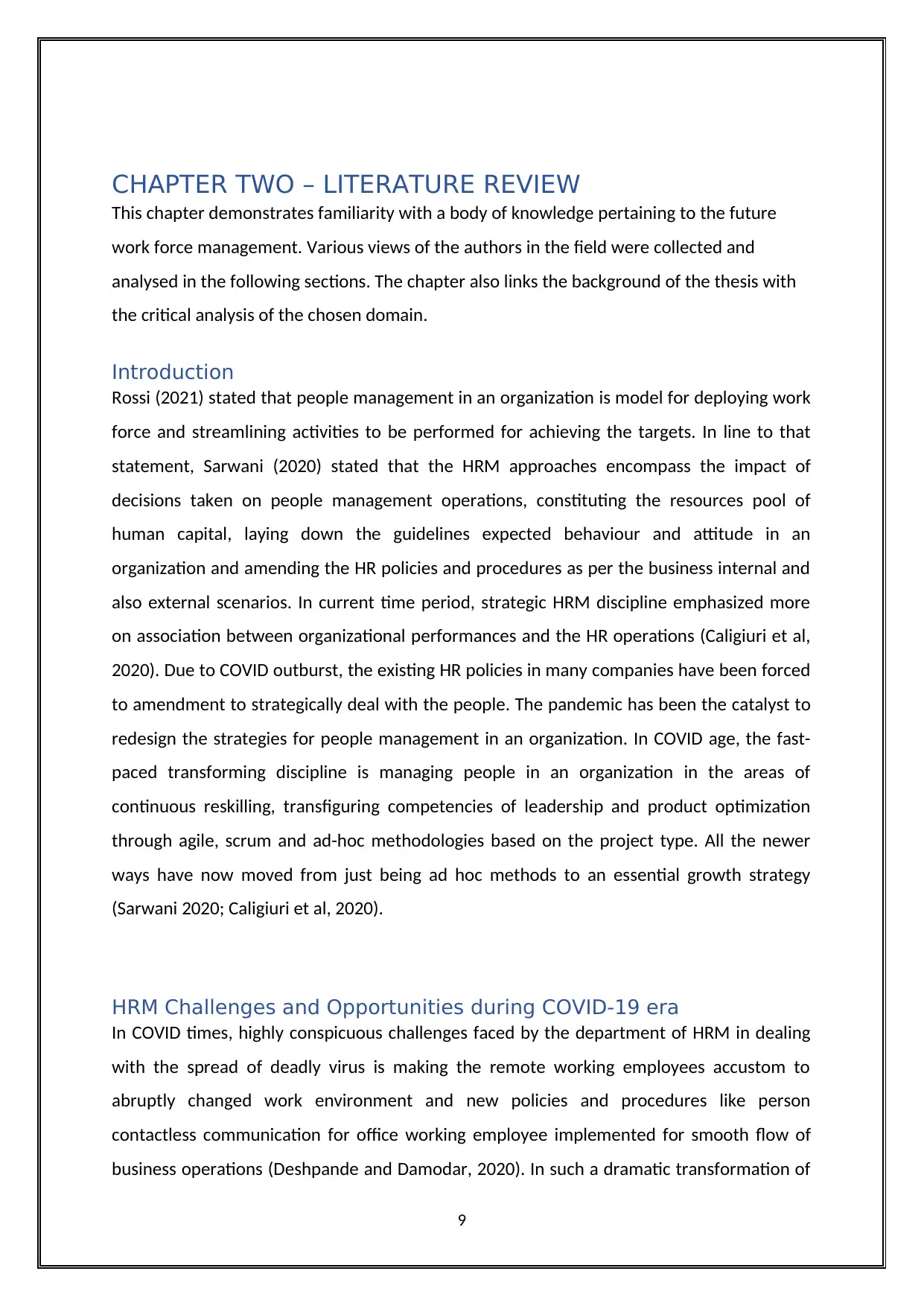
CHAPTER TWO – LITERATURE REVIEW
This chapter demonstrates familiarity with a body of knowledge pertaining to the future
work force management. Various views of the authors in the field were collected and
analysed in the following sections. The chapter also links the background of the thesis with
the critical analysis of the chosen domain.
Introduction
Rossi (2021) stated that people management in an organization is model for deploying work
force and streamlining activities to be performed for achieving the targets. In line to that
statement, Sarwani (2020) stated that the HRM approaches encompass the impact of
decisions taken on people management operations, constituting the resources pool of
human capital, laying down the guidelines expected behaviour and attitude in an
organization and amending the HR policies and procedures as per the business internal and
also external scenarios. In current time period, strategic HRM discipline emphasized more
on association between organizational performances and the HR operations (Caligiuri et al,
2020). Due to COVID outburst, the existing HR policies in many companies have been forced
to amendment to strategically deal with the people. The pandemic has been the catalyst to
redesign the strategies for people management in an organization. In COVID age, the fast-
paced transforming discipline is managing people in an organization in the areas of
continuous reskilling, transfiguring competencies of leadership and product optimization
through agile, scrum and ad-hoc methodologies based on the project type. All the newer
ways have now moved from just being ad hoc methods to an essential growth strategy
(Sarwani 2020; Caligiuri et al, 2020).
HRM Challenges and Opportunities during COVID-19 era
In COVID times, highly conspicuous challenges faced by the department of HRM in dealing
with the spread of deadly virus is making the remote working employees accustom to
abruptly changed work environment and new policies and procedures like person
contactless communication for office working employee implemented for smooth flow of
business operations (Deshpande and Damodar, 2020). In such a dramatic transformation of
9
This chapter demonstrates familiarity with a body of knowledge pertaining to the future
work force management. Various views of the authors in the field were collected and
analysed in the following sections. The chapter also links the background of the thesis with
the critical analysis of the chosen domain.
Introduction
Rossi (2021) stated that people management in an organization is model for deploying work
force and streamlining activities to be performed for achieving the targets. In line to that
statement, Sarwani (2020) stated that the HRM approaches encompass the impact of
decisions taken on people management operations, constituting the resources pool of
human capital, laying down the guidelines expected behaviour and attitude in an
organization and amending the HR policies and procedures as per the business internal and
also external scenarios. In current time period, strategic HRM discipline emphasized more
on association between organizational performances and the HR operations (Caligiuri et al,
2020). Due to COVID outburst, the existing HR policies in many companies have been forced
to amendment to strategically deal with the people. The pandemic has been the catalyst to
redesign the strategies for people management in an organization. In COVID age, the fast-
paced transforming discipline is managing people in an organization in the areas of
continuous reskilling, transfiguring competencies of leadership and product optimization
through agile, scrum and ad-hoc methodologies based on the project type. All the newer
ways have now moved from just being ad hoc methods to an essential growth strategy
(Sarwani 2020; Caligiuri et al, 2020).
HRM Challenges and Opportunities during COVID-19 era
In COVID times, highly conspicuous challenges faced by the department of HRM in dealing
with the spread of deadly virus is making the remote working employees accustom to
abruptly changed work environment and new policies and procedures like person
contactless communication for office working employee implemented for smooth flow of
business operations (Deshpande and Damodar, 2020). In such a dramatic transformation of
9
⊘ This is a preview!⊘
Do you want full access?
Subscribe today to unlock all pages.

Trusted by 1+ million students worldwide
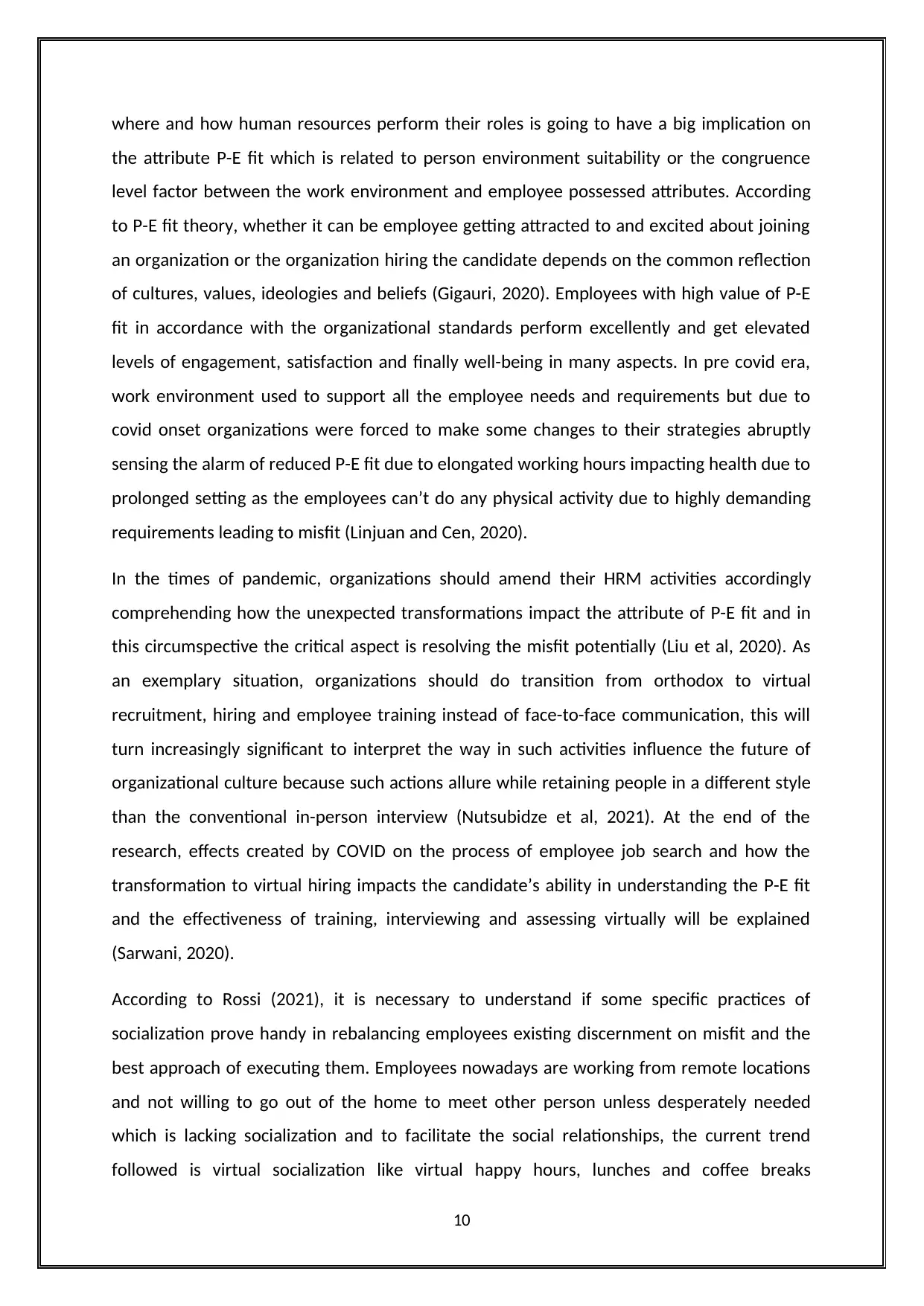
where and how human resources perform their roles is going to have a big implication on
the attribute P-E fit which is related to person environment suitability or the congruence
level factor between the work environment and employee possessed attributes. According
to P-E fit theory, whether it can be employee getting attracted to and excited about joining
an organization or the organization hiring the candidate depends on the common reflection
of cultures, values, ideologies and beliefs (Gigauri, 2020). Employees with high value of P-E
fit in accordance with the organizational standards perform excellently and get elevated
levels of engagement, satisfaction and finally well-being in many aspects. In pre covid era,
work environment used to support all the employee needs and requirements but due to
covid onset organizations were forced to make some changes to their strategies abruptly
sensing the alarm of reduced P-E fit due to elongated working hours impacting health due to
prolonged setting as the employees can’t do any physical activity due to highly demanding
requirements leading to misfit (Linjuan and Cen, 2020).
In the times of pandemic, organizations should amend their HRM activities accordingly
comprehending how the unexpected transformations impact the attribute of P-E fit and in
this circumspective the critical aspect is resolving the misfit potentially (Liu et al, 2020). As
an exemplary situation, organizations should do transition from orthodox to virtual
recruitment, hiring and employee training instead of face-to-face communication, this will
turn increasingly significant to interpret the way in such activities influence the future of
organizational culture because such actions allure while retaining people in a different style
than the conventional in-person interview (Nutsubidze et al, 2021). At the end of the
research, effects created by COVID on the process of employee job search and how the
transformation to virtual hiring impacts the candidate’s ability in understanding the P-E fit
and the effectiveness of training, interviewing and assessing virtually will be explained
(Sarwani, 2020).
According to Rossi (2021), it is necessary to understand if some specific practices of
socialization prove handy in rebalancing employees existing discernment on misfit and the
best approach of executing them. Employees nowadays are working from remote locations
and not willing to go out of the home to meet other person unless desperately needed
which is lacking socialization and to facilitate the social relationships, the current trend
followed is virtual socialization like virtual happy hours, lunches and coffee breaks
10
the attribute P-E fit which is related to person environment suitability or the congruence
level factor between the work environment and employee possessed attributes. According
to P-E fit theory, whether it can be employee getting attracted to and excited about joining
an organization or the organization hiring the candidate depends on the common reflection
of cultures, values, ideologies and beliefs (Gigauri, 2020). Employees with high value of P-E
fit in accordance with the organizational standards perform excellently and get elevated
levels of engagement, satisfaction and finally well-being in many aspects. In pre covid era,
work environment used to support all the employee needs and requirements but due to
covid onset organizations were forced to make some changes to their strategies abruptly
sensing the alarm of reduced P-E fit due to elongated working hours impacting health due to
prolonged setting as the employees can’t do any physical activity due to highly demanding
requirements leading to misfit (Linjuan and Cen, 2020).
In the times of pandemic, organizations should amend their HRM activities accordingly
comprehending how the unexpected transformations impact the attribute of P-E fit and in
this circumspective the critical aspect is resolving the misfit potentially (Liu et al, 2020). As
an exemplary situation, organizations should do transition from orthodox to virtual
recruitment, hiring and employee training instead of face-to-face communication, this will
turn increasingly significant to interpret the way in such activities influence the future of
organizational culture because such actions allure while retaining people in a different style
than the conventional in-person interview (Nutsubidze et al, 2021). At the end of the
research, effects created by COVID on the process of employee job search and how the
transformation to virtual hiring impacts the candidate’s ability in understanding the P-E fit
and the effectiveness of training, interviewing and assessing virtually will be explained
(Sarwani, 2020).
According to Rossi (2021), it is necessary to understand if some specific practices of
socialization prove handy in rebalancing employees existing discernment on misfit and the
best approach of executing them. Employees nowadays are working from remote locations
and not willing to go out of the home to meet other person unless desperately needed
which is lacking socialization and to facilitate the social relationships, the current trend
followed is virtual socialization like virtual happy hours, lunches and coffee breaks
10
Paraphrase This Document
Need a fresh take? Get an instant paraphrase of this document with our AI Paraphraser
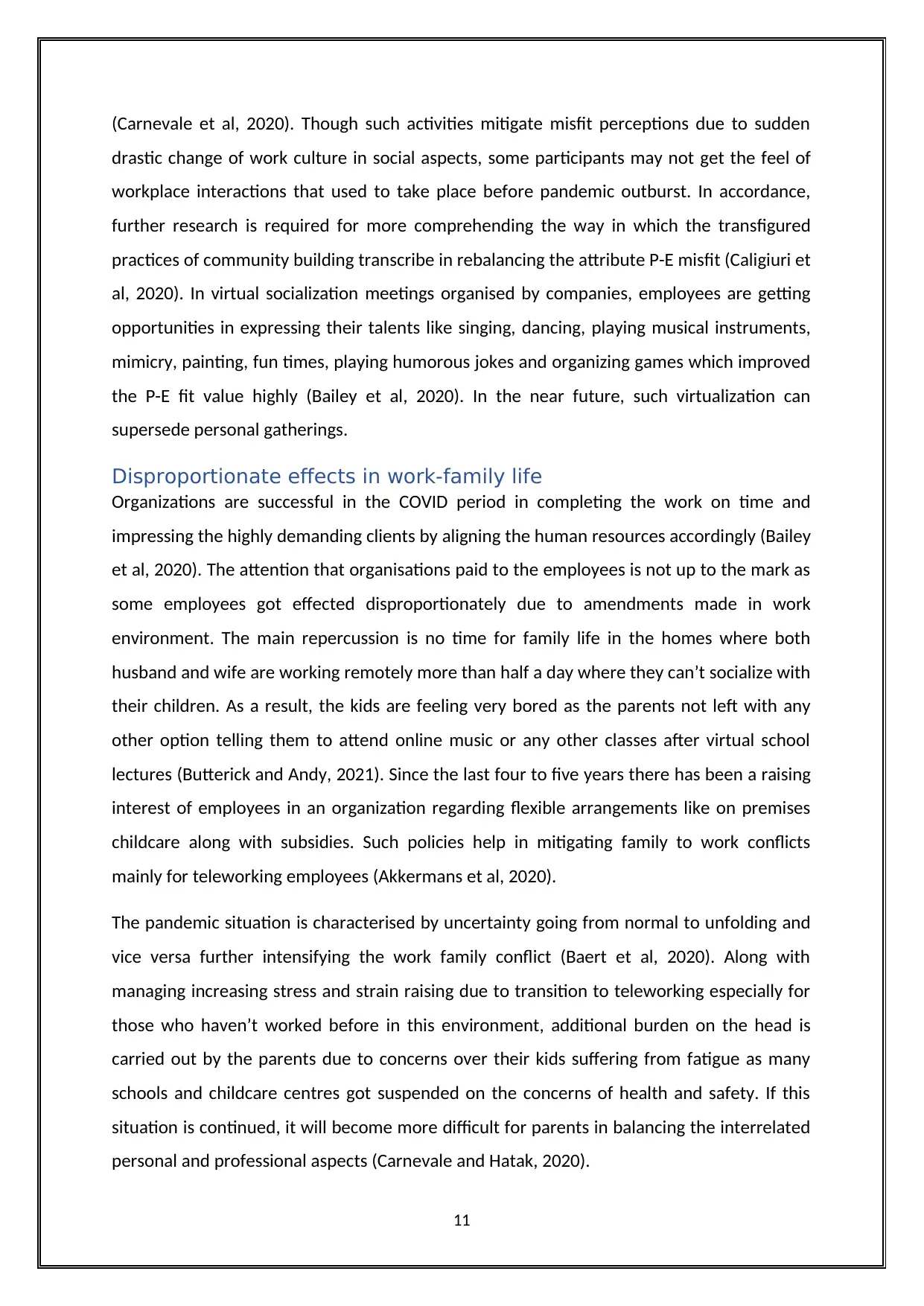
(Carnevale et al, 2020). Though such activities mitigate misfit perceptions due to sudden
drastic change of work culture in social aspects, some participants may not get the feel of
workplace interactions that used to take place before pandemic outburst. In accordance,
further research is required for more comprehending the way in which the transfigured
practices of community building transcribe in rebalancing the attribute P-E misfit (Caligiuri et
al, 2020). In virtual socialization meetings organised by companies, employees are getting
opportunities in expressing their talents like singing, dancing, playing musical instruments,
mimicry, painting, fun times, playing humorous jokes and organizing games which improved
the P-E fit value highly (Bailey et al, 2020). In the near future, such virtualization can
supersede personal gatherings.
Disproportionate effects in work-family life
Organizations are successful in the COVID period in completing the work on time and
impressing the highly demanding clients by aligning the human resources accordingly (Bailey
et al, 2020). The attention that organisations paid to the employees is not up to the mark as
some employees got effected disproportionately due to amendments made in work
environment. The main repercussion is no time for family life in the homes where both
husband and wife are working remotely more than half a day where they can’t socialize with
their children. As a result, the kids are feeling very bored as the parents not left with any
other option telling them to attend online music or any other classes after virtual school
lectures (Butterick and Andy, 2021). Since the last four to five years there has been a raising
interest of employees in an organization regarding flexible arrangements like on premises
childcare along with subsidies. Such policies help in mitigating family to work conflicts
mainly for teleworking employees (Akkermans et al, 2020).
The pandemic situation is characterised by uncertainty going from normal to unfolding and
vice versa further intensifying the work family conflict (Baert et al, 2020). Along with
managing increasing stress and strain raising due to transition to teleworking especially for
those who haven’t worked before in this environment, additional burden on the head is
carried out by the parents due to concerns over their kids suffering from fatigue as many
schools and childcare centres got suspended on the concerns of health and safety. If this
situation is continued, it will become more difficult for parents in balancing the interrelated
personal and professional aspects (Carnevale and Hatak, 2020).
11
drastic change of work culture in social aspects, some participants may not get the feel of
workplace interactions that used to take place before pandemic outburst. In accordance,
further research is required for more comprehending the way in which the transfigured
practices of community building transcribe in rebalancing the attribute P-E misfit (Caligiuri et
al, 2020). In virtual socialization meetings organised by companies, employees are getting
opportunities in expressing their talents like singing, dancing, playing musical instruments,
mimicry, painting, fun times, playing humorous jokes and organizing games which improved
the P-E fit value highly (Bailey et al, 2020). In the near future, such virtualization can
supersede personal gatherings.
Disproportionate effects in work-family life
Organizations are successful in the COVID period in completing the work on time and
impressing the highly demanding clients by aligning the human resources accordingly (Bailey
et al, 2020). The attention that organisations paid to the employees is not up to the mark as
some employees got effected disproportionately due to amendments made in work
environment. The main repercussion is no time for family life in the homes where both
husband and wife are working remotely more than half a day where they can’t socialize with
their children. As a result, the kids are feeling very bored as the parents not left with any
other option telling them to attend online music or any other classes after virtual school
lectures (Butterick and Andy, 2021). Since the last four to five years there has been a raising
interest of employees in an organization regarding flexible arrangements like on premises
childcare along with subsidies. Such policies help in mitigating family to work conflicts
mainly for teleworking employees (Akkermans et al, 2020).
The pandemic situation is characterised by uncertainty going from normal to unfolding and
vice versa further intensifying the work family conflict (Baert et al, 2020). Along with
managing increasing stress and strain raising due to transition to teleworking especially for
those who haven’t worked before in this environment, additional burden on the head is
carried out by the parents due to concerns over their kids suffering from fatigue as many
schools and childcare centres got suspended on the concerns of health and safety. If this
situation is continued, it will become more difficult for parents in balancing the interrelated
personal and professional aspects (Carnevale and Hatak, 2020).
11
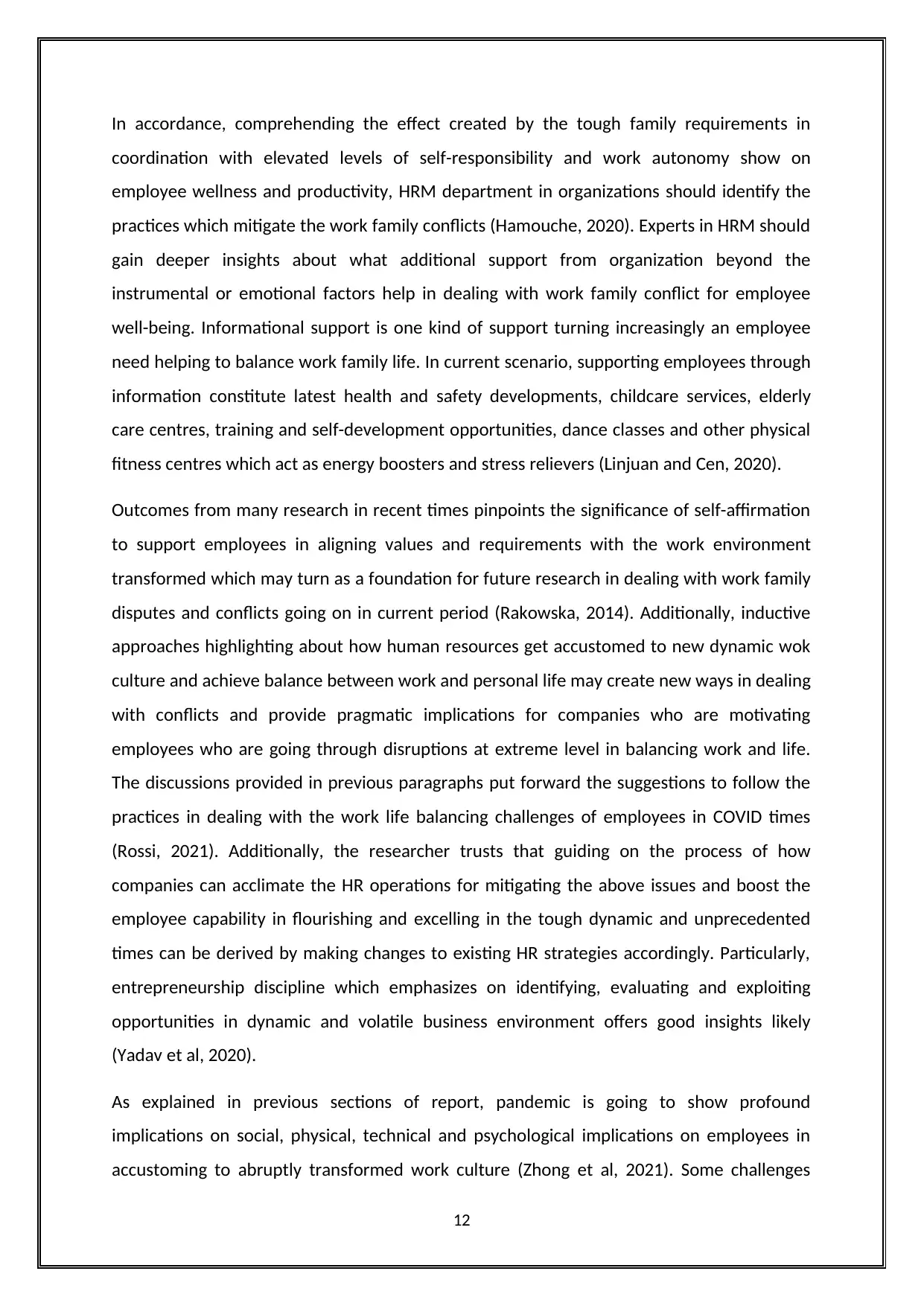
In accordance, comprehending the effect created by the tough family requirements in
coordination with elevated levels of self-responsibility and work autonomy show on
employee wellness and productivity, HRM department in organizations should identify the
practices which mitigate the work family conflicts (Hamouche, 2020). Experts in HRM should
gain deeper insights about what additional support from organization beyond the
instrumental or emotional factors help in dealing with work family conflict for employee
well-being. Informational support is one kind of support turning increasingly an employee
need helping to balance work family life. In current scenario, supporting employees through
information constitute latest health and safety developments, childcare services, elderly
care centres, training and self-development opportunities, dance classes and other physical
fitness centres which act as energy boosters and stress relievers (Linjuan and Cen, 2020).
Outcomes from many research in recent times pinpoints the significance of self-affirmation
to support employees in aligning values and requirements with the work environment
transformed which may turn as a foundation for future research in dealing with work family
disputes and conflicts going on in current period (Rakowska, 2014). Additionally, inductive
approaches highlighting about how human resources get accustomed to new dynamic wok
culture and achieve balance between work and personal life may create new ways in dealing
with conflicts and provide pragmatic implications for companies who are motivating
employees who are going through disruptions at extreme level in balancing work and life.
The discussions provided in previous paragraphs put forward the suggestions to follow the
practices in dealing with the work life balancing challenges of employees in COVID times
(Rossi, 2021). Additionally, the researcher trusts that guiding on the process of how
companies can acclimate the HR operations for mitigating the above issues and boost the
employee capability in flourishing and excelling in the tough dynamic and unprecedented
times can be derived by making changes to existing HR strategies accordingly. Particularly,
entrepreneurship discipline which emphasizes on identifying, evaluating and exploiting
opportunities in dynamic and volatile business environment offers good insights likely
(Yadav et al, 2020).
As explained in previous sections of report, pandemic is going to show profound
implications on social, physical, technical and psychological implications on employees in
accustoming to abruptly transformed work culture (Zhong et al, 2021). Some challenges
12
coordination with elevated levels of self-responsibility and work autonomy show on
employee wellness and productivity, HRM department in organizations should identify the
practices which mitigate the work family conflicts (Hamouche, 2020). Experts in HRM should
gain deeper insights about what additional support from organization beyond the
instrumental or emotional factors help in dealing with work family conflict for employee
well-being. Informational support is one kind of support turning increasingly an employee
need helping to balance work family life. In current scenario, supporting employees through
information constitute latest health and safety developments, childcare services, elderly
care centres, training and self-development opportunities, dance classes and other physical
fitness centres which act as energy boosters and stress relievers (Linjuan and Cen, 2020).
Outcomes from many research in recent times pinpoints the significance of self-affirmation
to support employees in aligning values and requirements with the work environment
transformed which may turn as a foundation for future research in dealing with work family
disputes and conflicts going on in current period (Rakowska, 2014). Additionally, inductive
approaches highlighting about how human resources get accustomed to new dynamic wok
culture and achieve balance between work and personal life may create new ways in dealing
with conflicts and provide pragmatic implications for companies who are motivating
employees who are going through disruptions at extreme level in balancing work and life.
The discussions provided in previous paragraphs put forward the suggestions to follow the
practices in dealing with the work life balancing challenges of employees in COVID times
(Rossi, 2021). Additionally, the researcher trusts that guiding on the process of how
companies can acclimate the HR operations for mitigating the above issues and boost the
employee capability in flourishing and excelling in the tough dynamic and unprecedented
times can be derived by making changes to existing HR strategies accordingly. Particularly,
entrepreneurship discipline which emphasizes on identifying, evaluating and exploiting
opportunities in dynamic and volatile business environment offers good insights likely
(Yadav et al, 2020).
As explained in previous sections of report, pandemic is going to show profound
implications on social, physical, technical and psychological implications on employees in
accustoming to abruptly transformed work culture (Zhong et al, 2021). Some challenges
12
⊘ This is a preview!⊘
Do you want full access?
Subscribe today to unlock all pages.

Trusted by 1+ million students worldwide
1 out of 48
Related Documents
Your All-in-One AI-Powered Toolkit for Academic Success.
+13062052269
info@desklib.com
Available 24*7 on WhatsApp / Email
![[object Object]](/_next/static/media/star-bottom.7253800d.svg)
Unlock your academic potential
Copyright © 2020–2025 A2Z Services. All Rights Reserved. Developed and managed by ZUCOL.





